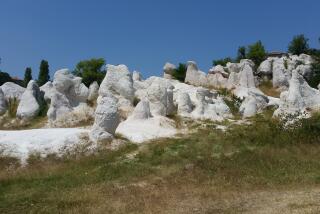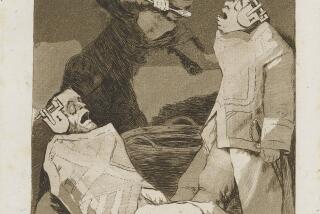MASON & DIXON.<i> By Thomas Pynchon</i> .<i> Henry Holt: 773 pp., $27.50</i>
- Share via
What is history, what is civilization, what are the limits of our ability to know? It is Thomas Pynchon’s great distinction in his four previous novels and now in the dizzying and encyclopedic “Mason & Dixon” to have repeatedly brought extra-literary rhetorics to bear on these, the most pressing questions literature can address. At different times, he has kidnapped to his cause the languages of tourism and prosthesis (“V.,” 1963); Jacobean drama, philately and thermodynamics (“The Crying of Lot 49,” 1966); rocketry, information theory, behavioral psychology, anthropology and chemical engineering (“Gravity’s Rainbow,” 1973); 1960s American counterculture (“Vineland,” 1990); and cinema lore, psychopharmacology and popular song lyrics of all kinds.
This semantic acquisitiveness has not made for smooth development from book to book. The deliberately digressive sprawl of “V.” can, at times, appear to be called into question by the near-mineral concision of “The Crying of Lot 49,” which immediately followed it. Conversely, “Gravity’s Rainbow” is so grandly architectural in structure that the comparatively artless “Vineland” almost seems to have been written by a different hand (as indeed some of Pynchon’s more adamant fans insist it was). The cumulative effect, though, has been nothing if not enlivening. No one else now writing has done more to refresh the novel’s means or, in so doing, put them to better purpose.
“Mason & Dixon,” said to have been more than 20 years in the making, is a vast, indeed encompassing, meditation on the Enlightenment and its consequences, with Pynchon this time appropriating the syntax of 18th century astronomy and geodesy to structure and advance his tale. Like “Gravity’s Rainbow,” the book is quietly keyed to the Christian liturgical calendar, unfolding in a succession of afternoons from Advent to Epiphany, as the witty and avowedly unreliable Rev. Wicks Cherrycoke entertains his sister’s children with reminiscences of his far-flung travels. It is through Cherrycoke, then, that we learn the story of British astronomer Charles Mason and his partner, surveyor Jeremiah Dixon, from their first meeting in 1761 to Mason’s death 25 years later.
Structurally, as one character points out, this chronicle has the A-B-A form of that 18th century invention, the sandwich: a pair of astronomical observations with an extended survey expedition in between. Mason and Dixon meet in 1761 when the Royal Society appoints them to observe the much-anticipated Transit of Venus, a rare alignment of the Earth, sun and Venus that will for the first time make it possible to calculate the solar parallax and so, in turn, the exact distance from Earth to sun.
Although meant to make their “Obs” from Bencoolen, on the western coast of Sumatra, the pair have a run-in with a French frigate and are forced instead to settle for the Dutch colony at Cape Town. From there, Mason and Dixon make their way first to St. Helena, where Mason works with British astronomer Nevil Maskelyne collecting tidal data, then on to Philadelphia, Mount Vernon and, finally, the virgin forests of the Allegheny Mountains. There, they undertake the work for which they are now best known: laying out the Mason-Dixon Line that would separate Maryland and the rest of the slave-holding states from Pennsylvania and the abolitionist North. It is a complex project, made all the more difficult by the harshness of the American wilderness, and the two men spend four years in its service. Finally, they return to Britain, where the Second Transit to Venus (transits come in pairs) brings the cycle of their labors to a close in 1769.
Thus the rationalist bones of the tale, with Mason and Dixon methodically working to subdue nature in a grid of orthogonals and finely reckoned figures, the very picture of Enlightenment Europe’s faith in reason, natural law and the moral perfectibility of man. As they triangulate their way across the heavens and Earth, however, reason quickly proves to be the least of it. Bursting from the interstices of the expedition’s “official” account are alternative histories, parageographies, marginal sciences, cryptic systems and arcana so profuse that any talk of “the rule of right reason” soon seems hubris, pure and simple.
Mesmerism, animism, feng shui, Hollow-Earth anthropologies, Freemasonry, astral projection, Gaia worship, reflexology, diabolism, curative electricity, astrology, geomancy, alien visitation--such quasi-mystical beliefs exfoliate from the novel’s every corner with an abundance that mimics the American wilderness itself. What’s more, neither Mason nor Dixon seems at all inclined to dismiss these nonrational bodies of knowledge, at least not without due consideration. Emissaries of order and “mathesis” they may be, but the duo are also sensitive to the vast potential for destruction that accompanies any claim to “objective” truth. The Enlightenment that produced Diderot and the Encyclopedists will soon enough produce the Terror.
This, of course, is quintessential Pynchon. All his published work reflects a passion for knowledge systems that have been marginalized, concealed or discredited by the presiding official discourse. In the characters of Mason and Dixon, moreover--men sworn to the spirit of rational inquiry--Pynchon has found the perfect means for approaching these alternative modes of thought. No sooner has Rev. Cherrycoke described Mason and Dixon’s first meeting (the rather more worldly Mason takes Dixon to a hanging) than they encounter the Learned English Dog (a.k.a. Fang), a “disheveled English Terrier, with a raffish Gleam in its eye.” True to his billing, the dog has an admirable education and, what’s more, an elocutionary manner to match. Mason, who throughout the book mourns his wife Rebekah’s untimely death, is instantly intrigued:
“ ‘Dixon. Why mayn’t there be Oracles, for us, in our time? Gate-ways to Futurity? That can’t all have died with the ancient Peoples. Isn’t it worth looking ridiculous, at least to investigate this English Dog, for its obvious bearing upon Metempsychosis if nought else. . . .’ ”
Dixon agrees and, when they are alone with the dog, Mason pops the question:
“ ‘There is something I must know,’ Mason hoarsely whispers, in the tone of a lover tormented by Doubts, ‘Have you a soul--that is, are you a human Spirit, reincarnate as a Dog?’
“The L.E.D. blinks, shivers, nods in a resign’d way. ‘You are hardly the first to ask. . . . But please do not come to the Learned English Dog if it’s religious Comfort you’re after. I may be praeternatural, but I am not supernatural. ‘Tis the Age of Reason, rrrf? There is ever an explanation at hand, and no such thing as a Talking Dog--Talking Dogs belong with Dragons and Unicorns. What there are, however, are Provisions for Survival in a World less fantastick.’
‘Viz.--Once, the only reason Men kept Dogs was for food. Noting that among Men no crime was quite so abhor’d as eating the flesh of another human, Dog quickly learn’d to act as human as possible--and to pass this Ability on from Parents to Pups. So we know how to evoke from you, Man, one day at a time, at least enough Mercy for one day more of Life. . . . I am but an extreme expression of this Process.’ ”
It is a sobering rebuke, at once bitter and resigned, and for Mason especially the L.E.D. has here set the terms for all that is to follow.
The story unfolds in picaresque fashion, taking its momentum mostly from Mason and Dixon’s progress through the stations of their journey. Episodes involving historical figures--George and Martha Washington, Ben Franklin, James Boswell and Doctor Samuel Johnson, royal astronomers James Bradley and Nevil Maskelyne--are freely muted with others that introduce characters more fully fanciful: feng shui crusader Captain Zhang; Jesuit commando Father Zarpazo (a.k.a. the Lord of the Zero); werebeaver Zepho Beck; a land-locked electric eel named Felipe; a true conqueror Worm; and, memorably, Jacques de Vaucanson’s celebrated clockwork duck, here given an erotic upgrade and a shot at immortality.
More often than not, these episodes are self-contained, heaving into view like passages of landscape that reveal themselves once and are left behind, replaced by other vistas that in turn also pass from sight. Indeed, one begins to suspect after a while that it is the American earth itself--unsullied, savagely fertile--that is generating this superabundance of stories and interim protagonists. Pynchon (or his mouthpiece, Cherrycoke) repeatedly hints at such a possibility, though he is always careful to avoid the definitive utterance, the confining fact, the objective truth. No door is allowed to shut without two more being thrown open. And in the end, the only certainty to be found in Mason and Dixon’s America--at least the only one accorded the status of objective truth--is the line itself, a thing of reason rather than of nature, violently inscribed upon the body of the Earth. It is folly, it is fracture, and from it stems all the ills of our own American century, ripened now to rot. About this Pynchon is unambiguous. Here, to cite but one example among dozens, is the feng shui expert Captain Zhang on the subject:
“ ‘[The Line] acts as a Conduit for what we call Sha, or, as they say in Spanish California, Bad Energy. Imagine a Wind, a truly ill wind, bringing failure, poverty, disgrace, betrayal--every kind of bad luck there is--all blowing through, night and day, with many times the force of the worst storm you were ever in. . . .
“ ‘Ev’rywhere else on earth, Boundaries follow Nature--coast-lines, ridge-tops, river-banks--so honoring the Dragon or Sha within, from which Land-Scape ever takes its form.’ ”
Implicit in this assessment is an indictment of private property, arguably man’s most pernicious invention; after all, it was to settle a property dispute that the Mason-Dixon Line was commissioned in the first place. But the real offense of the line, like the offense of reason itself, is that it recognizes no authority beyond its own deductive principles, clinical and self-perpetuating. Whatever splendors bequeathed us by the Enlightenment, Pynchon leaves us to conclude, must be weighed against the moral and spiritual absence at its core. And that, he would surely add, is no contest at all.
In many ways, “Mason & Dixon” exhibits a restraint that we’ve not seen from Pynchon previously. Most notably absent are the set pieces of specialty sex--coprophilia, necrophilia and the like--that reached a crescendo in “Gravity’s Rainbow” (and, it is said, so inflamed the sensibilities of the 1974 Pulitzer committee that it could not bring itself to give anyone the fiction prize that year). But it’s not just the sex that has been toned down--violence, paranoia and plain old caca-mindedness also play a much-diminished role in “Mason & Dixon.” This moderating trend seems quite in keeping with the new book’s mise en scene and subject matter, but it also has the unlooked-for effect of allowing Pynchon to strike a variety of emotional registers that might otherwise have been lost in the fireworks.
Most obviously benefiting from the author’s new interest in emotional shading are his title characters. Mason and Dixon evidence a psychological complexity and depth lacking in Pynchon’s earlier protagonists. From the outset, the two are temperamentally at odds, but the years bring them plausibly closer and when, with most of their adventures behind them, Dixon tells Mason that they “must count on becoming old Geezers together,” the moment is genuinely affecting. By the same token, several key scenes--especially those dealing with slavery, for which Pynchon reserves his most withering scorn--achieve a moral and dramatic intensity that might well have been unavailable in the super-heated idiom of “Gravity’s Rainbow” or “V.”
Most great talents tend toward classicism as they mature, and classicism’s hallmarks and overall naturalness of form, easily discernible governing principles and absence of unbalancing tensions are everywhere evident in “Mason & Dixon.” Even the 18th century English, in which it is written, conforms serenely to Pynchon’s purpose. Not only is it historically accurate (as a cursory look at Mason and Dixon’s surviving letters confirms) but, through its convention of capitalizing dominant nouns, it also creates an undercurrent of quotidian idealism that keeps the book’s main theme constantly before us. A line is not necessarily a Line, any more than a zone (in “Gravity’s Rainbow”) is a Zone, but here the upper case arises naturally, without calling attention to the authorial intelligence.
Finally, though, it is the vision itself that one takes away from this remarkable book: a wilderness America, peopled as much by European hopes and longings as by the interlocking kingdoms of the indigenous; a virgin, undivided land. Until, one morning, two ordinary men appear, charged with cutting a perfectly straight line, eight yards wide, westward into its heart. . . .
It is a moment of surpassing beauty and sadness, a glimpse of something whose sense we can never take for granted or be lastingly done with--even when, as here, it has occasioned a masterpiece.
More to Read
Sign up for our Book Club newsletter
Get the latest news, events and more from the Los Angeles Times Book Club, and help us get L.A. reading and talking.
You may occasionally receive promotional content from the Los Angeles Times.







